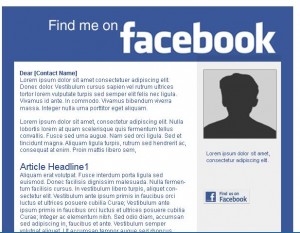by gabriel_sales | Jan 2, 2013
 Facebook.com is the most popular site in existence, getting more clicks than Google search since 2010. Within over 1 billion users, Facebook has become a highly effective part of many B2B digital marketing strategies.
Facebook.com is the most popular site in existence, getting more clicks than Google search since 2010. Within over 1 billion users, Facebook has become a highly effective part of many B2B digital marketing strategies.
Here are 10 Facebook for B2B Marketing social media tips:
- Make a ‘Fan’ Page for Your Business. These are different than personal profile pages, and Facebook simply calls them pages. This ‘fan’ page will be the platform where are of your communication and content will come from.
- Add a Discussion Forum. Facebook allows you to make subpages within your business page. Adding a place for discussion amongst your customers (and moderated by you) can be great sales research.
- Add Photos. Your page should display pictures alongside your name and description. Your photos can include company logos, pictures or your location, employees, etc. Just give people something to look at besides words.
- Post Videos. In addition to your channel on YouTube, your Facebook profile is another great place to upload our videos if you want them to be seen.
- Customize Your Page. While the overall structure or your page is predetermined by Facebook, they do give you several options to customize the look and content you present. Facebook has places for you to link to your business website and other social media accounts, which you should always do. Do everything you can to make your branding style on Facebook match your overall branding strategy.
- Encourage Customers to ‘Like’ and ‘Recommend’ Your Page. Every time someone clicks the ‘like’ button on your business’s page, they have automatically subscribed to all of the content you post. You can directly post on your Facebook page to ask people to like your page, but you should also coordinate your marketing campaign to include an invitation to ‘like’ your page on all of your different media outlets. Once you have people that have ‘liked’ your page, you can ask them to recommend it to others. This is a way of creating and exploiting brand loyalty by asking existing customers to recommend your business to new potential leads.
- Post Consistently About Topics of Interest. A Facebook page is not like a website; it needs to display new content on a regular basis. The easiest way to post new content is in the form of a ‘status update’. These are usually short messages that give updates on things like industry happenings or a new product launch. Keep in mind that if your posts seem irrelevant or annoying to your ‘fans’, they have the option to ‘unlike’ you. So, you should try to make sure all of your posts are at least interesting to your readers. You should aim to post something new to your page at least once a week, but daily is better.
- Ask Questions. People love to share their opinions on Facebook and feel like there voice is heard. You can therefore indulge them by asking questions related to your business or industry. Facebook even has the option to create a unique poll and invite your ‘fans’ to give their take on a specific issue. As a fortunate side effect of stimulating lively discussions on your page, you get free and real-time market research.
- Encourage Comments. This goes along with asking questions. If you ask the right questions, you can motivate people to respond by posting their opinions directly on your page about your products, services or general industry trends.
- Observe and Respond. Communication is a two-way street, which means you need to do more than just post status updates and ask questions. You need to also carefully monitor all of the posts and comments people leave you. If you not respond to your comments, you are left looking callous and disrespectful. If your customers are taking the time to interact with your business, you need to take the time to respond to them.
For more Facebook B2B Marketing social media tips from Gabriel Sales, please feel free to contact us.
by gabriel_sales | Dec 26, 2012
 Twitter is the most user friendly of the social media sites, which explains why it is usually the first site B2B companies integrate into their digital marketing campaigns. Twitter is kind of like Facebook, except there are only status updates, which Twitter calls ‘tweets’. Tweets can be no longer than 140 characters in length and can include messages, quotes, links to other sites, etc. All you need to do to use Twitter is sign up and then start posting tweets. Simple as pie (to get started).
Twitter is the most user friendly of the social media sites, which explains why it is usually the first site B2B companies integrate into their digital marketing campaigns. Twitter is kind of like Facebook, except there are only status updates, which Twitter calls ‘tweets’. Tweets can be no longer than 140 characters in length and can include messages, quotes, links to other sites, etc. All you need to do to use Twitter is sign up and then start posting tweets. Simple as pie (to get started).
Here are 9 tips for how to use Twitter for B2B marketing:
• Get People to Follow You. Pretty much the only way people will see your tweets is if they are following you; otherwise, you are basically shooting messages off to no one. You can invite people to follow you by including links to your Twitter account on your website, Facebook page and any other media platforms you use.
• Tweet. All the time. Posting tweets should be something you do constantly, as the people on Twitter crave constant, new information. This means that posting once or twice a month will get you nowhere on Twitter. General Electric has posted close to 60,000 tweets and is now at a rate of about 25 tweets per hour. While this may be logistically impossible for your business, it highlights the importance of tweeting, all the time.
• Be relevant. When it comes to the actual content of your tweets, you have a lot of freedom. The only thing you have to do is be interesting and relevant to the people who follow you. Whether you tweet about an industry trend or a problem you helped solve for one of your clients, your tweets should always stay on topic to things your followers are interested in.
• Keep it Short. Because you have a limit of 140 characters per tweet, the rules of grammar are allowed to temporarily go out the window. On Twitter, it is normal and acceptable to use contractions, abbreviations and acronyms and also to forgo punctuation entirely.
• Separate Longer Posts. Tweets work best when they are focused on a single though or idea. If you have an idea that takes longer to explain or has multiple parts, break it up into chunks centered around each point.
• Link to Additional Information. Sometimes, you want to convey a message that is too complex to fit Twitter’s character limit. If this happens, you can instead post a blurb or summary of your message, and add a link to the full story. Websites like bit.ly will shorten long URLs into shorter ones to give you additional character room in tweets.
• Tweet Your Other Media. You can also use your tweets to promote your other digital marketing content. Every time you post on Facebook, you should tweet about it and include a link to the Facebook post. The same thing goes every time you have a new blog post. To make this process faster, there are apps you can download, like Tweetcaster or Tweetdeck, that will simultaneously post the same message to all of your social media sites.
• Use #Hashtags. Whenever you add a pound sign in front of a word or phrase, you have what Twitter calls a hashtag. Hashtags function on Twitter like a sort of keyword. Every time a hashtag appears, you can click on it, and it will take you to a list of tweets that contain the same hashtag. Hashtags are therefore a great way to find new followers who are interested in the same keywords you are.
• Monitor Your Tweets. On Twitter, users have the option of ‘favoriting’ or responding to your tweets. If you are tweeting effectively, you will probably have customers or potential clients using these options to engage with you. This means you cannot create a Twitter account and simply leave it there.
We hope this blog has been helpful in learning how to use Twitter for B2B marketing. If you would like more information, please contact us.
by gabriel_sales | Dec 14, 2012
 In a previous blog, we discussed the three most common types of videos used in B2B sales. This is the second of a two part blog series where we will build on that discussion by offering additional tips for creating b to b product introduction videos.
In a previous blog, we discussed the three most common types of videos used in B2B sales. This is the second of a two part blog series where we will build on that discussion by offering additional tips for creating b to b product introduction videos.
- Don’t go for the hard sell. Research has shown that the hard sell does not work very well online. Online sales content is usually most effective in the education and retention phases, which means your videos should (usually) have these goals in mind. Creating an instructional or educational type video that details how your product or service is used will be much more effective than simply bombarding your viewer with your sales pitch.
- Keep Things New and Fresh. As we’ve stated before, there are now over 24 hours of new video content uploaded to YouTube every minute. This means that the video you uploaded last week is already old news. Your company’s YouTube channel will quickly become stagnant if it is not constantly producing new content. Even if you have to simply say the same message in a different way, you should constantly be updating and revitalizing your video content.
- Be Focused. By keeping your videos focused on single message, you avoid overwhelming your viewer with your entire product line or the complexities of one of one of your service options. The easiest way to stay focused is to follow this guideline: For each product or service, you should have a separate video.
- Simple is Best. One of the misconceptions about producing videos for online B2B sales is that they are extremely difficult and costly to make. This does not have to be the case. Videos for B2B sales should adhere to the old adage, “less is more.” You do not need to spend tons of money on special effects; actually, too many things going on can leave your video looking overproduced. Most YouTube viewers know they are going to get a lower-cost production value online, and are willing to accept this if your content is interesting enough.
- Give Viewers Your URL. The goal of creating these online videos is to get potential customers to then go to your website. They are much more likely do this if you have already told them how to get there. Place the URL for your website either as a slide at the end of your video or somewhere in the text description that accompanies it; although it preferable to do both. The key here is making sure the URL is legible and highly visible.
by gabriel_sales | Dec 12, 2012
 In a previous blog, we discussed the three most common types of videos used in B2B sales and marketing. This is the first of a two part blog series where we will build on that discussion by offering additional tips for creating the best b to b product introduction videos possible.
In a previous blog, we discussed the three most common types of videos used in B2B sales and marketing. This is the first of a two part blog series where we will build on that discussion by offering additional tips for creating the best b to b product introduction videos possible.
- Appear professional. If you are attempting to produce video content to achieve certain business objectives, your video should aesthetically reflect that intention. You want to appear as if you are an expert within your industry, and usually, expertise entails professionalism. Make sure everyone who appears in the video is dressed nicely and well lit. Make sure everyone’s microphone is functioning properly. The one exception to appearing ‘business-professional’ is in the case that you are trying to reach a younger or more ‘hip’ demographic. In that instance, it may make more sense to wear blue jeans and talk casually on a sofa. The key here is knowing who you want to talk to and how they want to be talked to.
- Film in HD. Nearly everything filmed today in shot in high definition, which means that your viewers will expect the same from you. Today, most HD cameras are fairly low-cost an easy to use.
- Use PowerPoint or a Slideshow. Not all videos require live action film. If your video is informative or educational in nature, it may make more sense to display a series of slides or a PowerPoint presentation and record your voice over it with some background music.
- Keep it Short. The average time spent on a webpage before leaving is now under one minute. This means that attention span is on the decline and you only have a few precious moments to capture your viewers’ interest. So, although the time limit on YouTube is 15 minutes, you probably do not want to make videos this long. B2B sales videos over 3 minutes in length do not usually end up with a lot of views, you should therefore aim for around the two-minute mark.
- Highlight Contrast. Creating visual contrast can be highly effective for sales videos. If you are dressed in black, stand in front of a white background, and visa versa. Brightly colored backgrounds (think red or magenta) can also work well because they stand out in search result pages that feature thumbnails.
- Provide Distinctive Value. Because there are now over 24 hours of new video content uploaded to YouTube every minute, you have to do something to stand out. Offer something in your videos that your viewers cannot get by going anywhere else, like industry insights and tips. If you can show them something unique and interesting that they find value in, they will keep coming back for more.
- Shoot for the Small Screen. When producing B2B sales videos, you have to keep in mind that most people will not click the ‘full-screen’ option when watching it. Therefore, you should craft your videos so that they look appealing when viewed in this small size. The easiest way to do this is to keep your videos as simple as you can, aesthetically speaking.
- Aim to Entertain. While this tip may not be as easy to achieve as the others, it is just as important. If you videos are purely informative and have a dry tone to match, no one is going to want to watch them. Your videos should be engaging and enjoyable at the very least, and funny if you’re really good. The most important thing is to make sure your viewer actually watches what you have put out there.
For more tips from Gabriel Sales on creating b to b product introduction videos or other digital sales content, please feel free to contact us.
by gabriel_sales | Dec 6, 2012
 Google+ is the newest player in the social networking game and by September 2012, it already had more than 400 million users. It is kind of like a highly organized Facebook that has ties to regular Google search.
Google+ is the newest player in the social networking game and by September 2012, it already had more than 400 million users. It is kind of like a highly organized Facebook that has ties to regular Google search.
This connection to regular Google search is what makes using Google+ for B2B marketing an asset. Here is how it works: if you post something to Google+, that post becomes automatically integrated into Google’s search engine. So, every post you make will show up in Google search results, but it will also effect future search results overall. Posts on Google+ related to your business can ultimately improve your SEO, which is something every B2B company can benefit from.
Here are some tips for effectively Using Google+ for B2B Marketing:
- Make a Business Page. Similar to Facebook, need to create a page designed for business, not a personal profile.
- Invite You Customers. Send out an invite to all of your existing customers inviting them to become your friend on Google+. You can do this through email, or via Facebook or Twitter; you should probably do all three.
- Add Content. Similar to Facebook, you want to give your readers something to look at besides words. This means you should upload your photos from Facebook and you videos from YouTube to Google+.
- Create ‘Circles’. Google+ allows you to make groups of friends, called circles, based on similar interests, topics, etc. When you create a circle, you can send posts only to the people within that circle. This allows for an excellent opportunity to use audience segmentation and create specific messages for people based on a variety of factors like geographic location, company size or industry.
- Post Consistently About Topics of Interest. Like Facebook and Twitter, Google+ requires you to post regularly if you want to stay relevant. Speaking of relevant, your posts should also be of interest interesting to the people following you. Do not post anything and everything that comes to mind; first make sure your idea is something worthwhile for your readers.
- Host Video Chats. Similar to Skype, Google+ allows you to host or participate in video chats including many people at the same time. You can use this feature to your advantage by hosting chats about frequently asked questions or a new product or service.
by gabriel_sales | Nov 30, 2012
 In a previous blog, we discussed 12 reasons why using an outsourced sales company for corporate blogging in B2B sales is effective. In this blog, we will outline exactly how to craft those blogs to make sure they are effective at every step of the sales cycle. While there are many different ways to purpose a blog, writing for reach and for acquisition are two of the most important.
In a previous blog, we discussed 12 reasons why using an outsourced sales company for corporate blogging in B2B sales is effective. In this blog, we will outline exactly how to craft those blogs to make sure they are effective at every step of the sales cycle. While there are many different ways to purpose a blog, writing for reach and for acquisition are two of the most important.
Blogging for Reach
Creating an outsourced sales blog can be a great way to attract new potential customers. The best way to do this is to provide your potential customer with something informative and useful. Make sure it is something they would actually like to read, not a notice about moving offices. The key to blogging to reach new customers is to keep it general and related to your industry overall.
Your blogs posts should seek to strike a balance between opinion, advice and news. Posts about specific products or services are good, but are not likely to catch the attention you are looking for. By offering your readers your opinion about what is happening in the industry, you are able to get your name out there and position yourself as an expert at the same time.
Blogging for Acquisition
Blogs can also be extremely effective in turning those potential customers into actual leads. In today’s market, the decision makers for B2B sales are going online to do their research. This means you have an opportunity to put the information they need right in front of them.
Rather than the general industry related blogs you wrote for reach, blogs for acquisition should be more specifically about your company. Here is your chance to discuss your products and services and why you think they can solve business problems. This is also a great place to answer frequently asked questions and display your success through case studies.
Blogging for acquisition should also include posts that familiarize your reader with who you are. You can do this by writing posts about key staff members or even have staff write blogs themselves. There is also no harm in writing up blurbs about any awards you have won. This adds a more personal aspect to your blogs, which makes you look more human and therefore easier to work with.
The goal to using an outsourced sales blog for acquisition is giving your potential customers information they are looking for. Help them to understand who you are as a company and how you help your customers succeed. If you give your reader all of the information they need to make a decision, you are one step closer to closing.
 Facebook.com is the most popular site in existence, getting more clicks than Google search since 2010. Within over 1 billion users, Facebook has become a highly effective part of many B2B digital marketing strategies.
Facebook.com is the most popular site in existence, getting more clicks than Google search since 2010. Within over 1 billion users, Facebook has become a highly effective part of many B2B digital marketing strategies.
 Twitter is the most user friendly of the social media sites, which explains why it is usually the first site B2B companies integrate into their digital marketing campaigns. Twitter is kind of like Facebook, except there are only status updates, which Twitter calls ‘tweets’. Tweets can be no longer than 140 characters in length and can include messages, quotes, links to other sites, etc. All you need to do to use Twitter is sign up and then start posting tweets. Simple as pie (to get started).
Twitter is the most user friendly of the social media sites, which explains why it is usually the first site B2B companies integrate into their digital marketing campaigns. Twitter is kind of like Facebook, except there are only status updates, which Twitter calls ‘tweets’. Tweets can be no longer than 140 characters in length and can include messages, quotes, links to other sites, etc. All you need to do to use Twitter is sign up and then start posting tweets. Simple as pie (to get started). In a previous blog, we discussed the three most common types of videos used in B2B sales. This is the second of a two part blog series where we will build on that discussion by offering additional tips for creating b to b product introduction videos.
In a previous blog, we discussed the three most common types of videos used in B2B sales. This is the second of a two part blog series where we will build on that discussion by offering additional tips for creating b to b product introduction videos. Google+ is the newest player in the social networking game and by September 2012, it already had more than 400 million users. It is kind of like a highly organized Facebook that has ties to regular Google search.
Google+ is the newest player in the social networking game and by September 2012, it already had more than 400 million users. It is kind of like a highly organized Facebook that has ties to regular Google search. In a
In a 